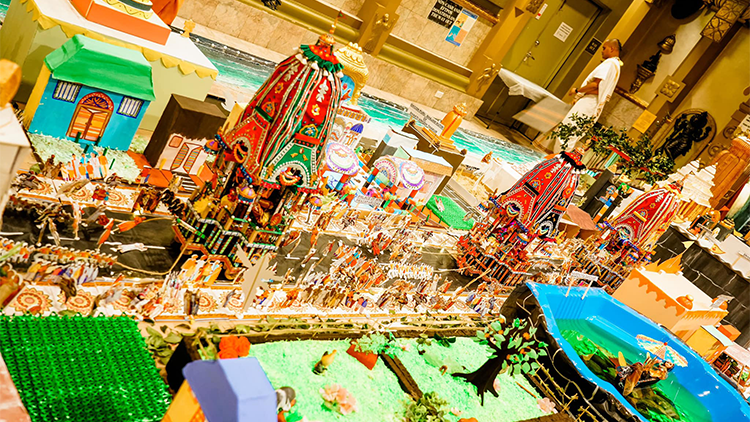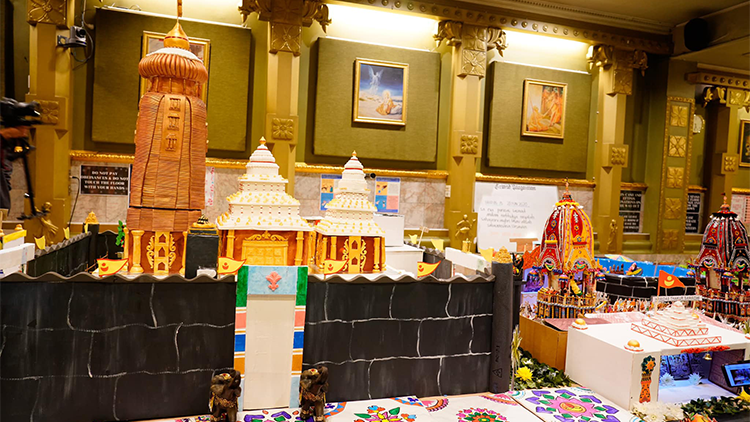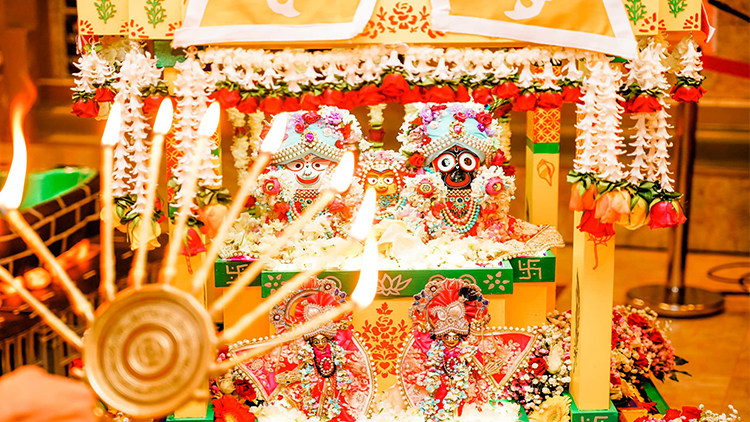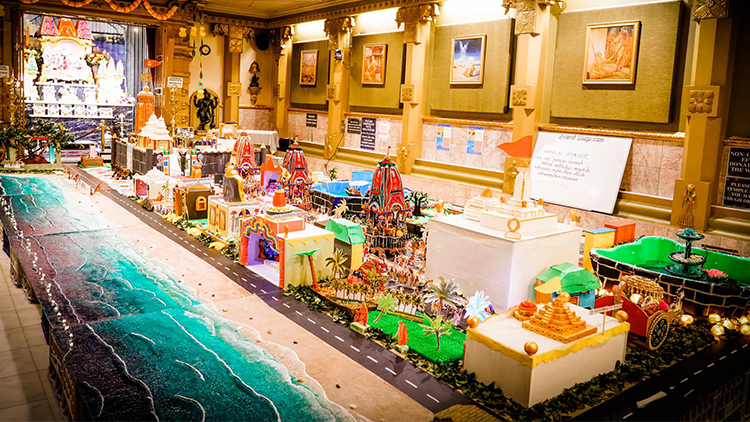Sydney Devotees Construct Detailed Jagannath Puri Replica
By Madhava Smullen | Jul 06, 2020

When devotees at the ISKCON temple in Sydney, Australia, couldn’t organize their regular full-fledged outdoor Rathayatra festival due to COVID-19 restrictions, they decided to bring the whole city of Puri and a new custom-built chariot into their temple room for a small indoor Rathayatra.
Carried out in consultation with head pujari Bhaja Govinda Das, the event for the pleasure of Their Lordships Sri Sri Jagannath, Baladeva and Subhadra took place on June 23rd, the date of the official Jagannath Puri Rathayatra.
Currently in the state of New South Wales, where Sydney is located, people are allowed to have 20 visitors in their home at any one time. Places of worship are allowed one person per 4 square meters (this does not determine the distance between people), meaning the Sydney temple room may accommodate 27 people. Masks are not compulsory in the state.
During the Rathayatra celebration, a maximum of only twelve devotees were in the temple room at a time, most of them regular priests. The event was not open to the public, and was broadcast online.

The Sri Jagannath Mandir made from cake
Second generation devotee Kirtan Rasa and Bhaktin Kritika custom built the beautiful new two-meter-tall chariot, with the assistance of six Bhakti Vriksha (congregation) members who helped with artwork and flower decoration.
Meanwhile the Puri replica was built and decorated by a team of Bhakti Vriksha members led by Congregation Leadership team member Sankirtan Narottam Das, and Bhakti Vriksha Development Leaders Anandamaya Gopinath Das and Sriguru Bhakti Devi Dasi.
Complying with local government regulations, a group of forty devotees divided into five teams spread between five different home locations, and developed parts of the replica separately. Each part was then brought to the temple and assembled on the morning of the Rathayatra.
“It took the forty devotees four weeks to finish the model,” says Temple Council Member Ghanashyam Govinda Das. “We followed all the COVID-safe precautionary measures during the process, and due to COVID-19 restrictions, the five teams took turns visiting the temple and assembling their respective parts on the day.”

Jagannath, Baladeva and Subhadra
When completed, the astonishingly detailed and gorgeous Jagannath Puri replica measured 26 x 12 feet, and featured a 5 x 4 foot Sri Jagannath Mandir with three towers made of cake.
The temple’s four entrance gates – Lion, Tiger, Horse and Elephant – were included, as were Ananda Bazaar; Snana Vedi with a fountain set up for Abhisekh of their Lordships; the Koili Vaikuntha garden; and small temples for Vimala Devi, Lakshmi Devi, Nila Madhava, Suryanarayana, Patita Pavana Jagannath and Sri Chaitanya Mahaprabhu’s Lotus Feet.
Twelve feet from the main Jagannath Mandir was the Gundicha temple, which Lord Chaitanya famously cleaned. Between the two was Grand Trunk road, with exact replicas of Jagannath, Baladeva and Subhadra’s three chariots and small models of more than 1,200 devotees.
Other sacred and historical spots included the temple of Bhaktisiddhanta Saraswati Thakur’s birthplace, Lord Nrsimhadeva’s temple, Indradyumna Sarovar, King Prataparudra’s Palace, Narendra Sarovar featuring Lord Jagannath’s boat pastime, and the Jagannath Vallabha Garden, depicting a pastime with King Prataparudra and Sri Chaitanya Mahaprabhu.

Narendra Sarovar featuring Lord Jagannath’s boat pastime
Behind the Sri Jagannath Mandir, devotees built the Gambhira, Sweta Ganga, Sarvabhauma Bhattacharya’s house, Lord Shiva temple and Siddha Bakula, including the famous bakula tree with Mahaprabhu instructing Haridas Thakura and Rupa and Sanatan Goswamis. Meanwhile on the Beach Road, devotees built the Samadhi Mandir of Haridas Thakur, ISKCON Puri, Chataka Parvat and Tota Gopinath Mandir. They also created the beach and the ocean, as well as models of twenty-five houses, twenty shops and several parks.
“The entire model was mounted on a base made from 180 milk crates tied to a piece of plywood,” says Ghanashyam Govinda. “The three towers of the main Mandir were made with cake, which took a dedicated team of five devotees four days to complete. The three chariots were made from wooden boards.”
The other temples in the replica were built with MDF boards. The domes were made with Plaster of Paris (created using molds made from incense stands, children’s toys, and milk bottles) and hand-painted by devotees.
The replica also featured 1,300 photos of devotees and pastimes, with matching mirror images printed on either side of polystyrene shapes to create a 3D effect. Ponds and lakes were made from repainted children’s bathtubs; and fountains were built from scratch using plastic plates, pipes and motors.

The Sri Nandanandana Garden
The houses and shops, meanwhile, were made with cardboard, hand-painted by devotee children. The parks were constructed from shredded coconut with green food coloring. The sea and shore were made with tissues pasted to plywood and painted. The Siddha Bakula tree was made with aluminium foil and tie wire, with leaves attached and the trunk painted brown. Finally, Patita Pavana Jagannath and Garuda in the Garuda Stambha were made with modeling clay.
“We had a lot of challenges along the way,” Ghanashyam Govinda says, describing how the initial chariot miniatures fell apart because the glue wouldn’t dry, and how difficult it was to coordinate and transport the work. “However, as we prayed to Lord Jagannath, we found them all getting resolved one by one.”
Ghanashyam Govinda explains that the project gave devotees a much-needed opportunity to serve together and be inspired, after missing each other’s association due to COVID-19.
“The devotees cherished it very much, and our relationship grew much stronger,” he says. “Everyone was very inspired by the final outcome, and we were all very humbly praying that Their Lordships would be pleased with this small service.”

Srila Haridas Thakur’s Samadhi
Once the whole Puri replica and chariot had been built, the indoor Rathayatra celebration was held. A few senior devotee leaders of the community pulled Jagannath, Baladeva, and Subhadra and Sri Sri Gaura Nitai around the Puri replica several times on Their new chariot. Priests also offered nine different bhoga offerings to Their Lordships. The event was broadcast live on Mayapur TV, Facebook and YouTube, much to the thrill of devotees as well as members of the wider community.
“Devotees’ response was very overwhelming,” says Ghanashyam Govinda. “Many were deeply touched by the event, and cried in ecstasy. Some said that it was one of the best festivals we have ever had in our temple in 49 years.”
After the event, Their Lordships’ maha prasad was freely distributed by “door delivery” to more than 1,200 members of diverse communities who had registered on ISKCON Sydney’s website.
“Encouraged by the success, our events team is planning to run more such events in the near future,” Ghanashyam Govinda says. “Festivals like these bring so much enthusiasm and positive vibes among us and we want to share them with everyone, especially in the current tough times.”

The astonishing 26 x 12 foot replica of Jagannath Puri















